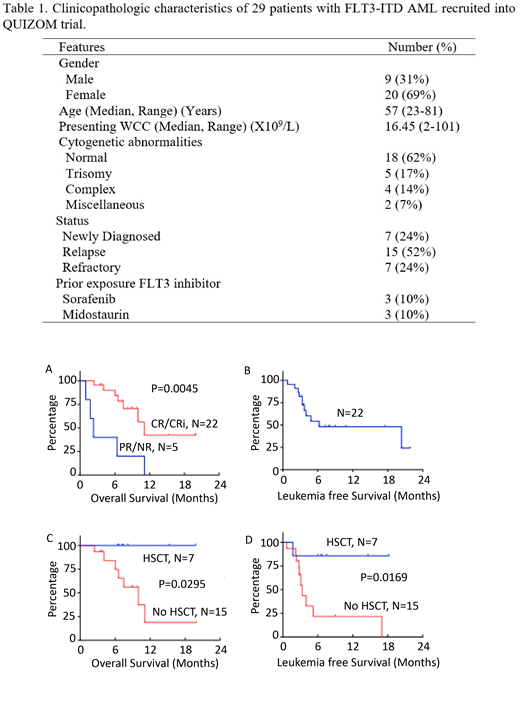Objectives: Acute myeloid leukemia (AML) carrying internal tandem duplication (ITD) of Fms-Like Tyrosine Kinase 3 (FLT3) is associated with high relapse risk and adverse outcome. This single-arm, phase 2 study evaluated efficacy and safety of combination treatment with FLT3 inhibitor quizartinib and protein translation inhibitor omacetaxine mepesuccinate (OME), referred herein QUIZOM - in elderly patients with newly diagnosed FLT3-ITD AML or young patients with relapsed/refractory (R/R) diseases, whose outcome is hitherto dismal.
Methods: R/R FLT3-ITD AML patients ≥ 18 years old or newly diagnosed patients ≥ 65 years old were recruited. Treatment comprised quizartinib 30 mg daily and OME [2 mg daily for 7 (first course) or 5 days (second course onwards) every 21-28 days] until disease progression or allogeneic hematopoietic stem cell transplantation (HSCT). Quizartinib was given as post HSCT maintenance after engraftment at doses ranging from 30 mg twice weekly to 30 mg daily, depending on blood counts. Primary endpoint was composite complete remission (CRc) defined by CR+CRi (CR with incomplete haematological recovery). Secondary endpoints were leukaemia-free (LFS) and overall survival (OS). Molecular responses were evaluated by FLT3-ITD based on PCR and NPM1 variant allele frequency (VAF) based on digital PCR (ddPCR). Mutation profiling was performed by MiSeq Next Generation Sequencing (NGS) based on IDT xGen Lockdown probes custom panel of 67 genes or TruSight myeloid panel of 54 genes.
Results: Twenty-nine patients (R/R case=22; newly diagnosed case=7) were recruited between November 2017 and July 2019. Their clinicopathologic characteristics were shown in Table 1. Twenty-seven patients completed at least one course of QUIZOM (median= 2 courses, range: 1-20 courses) of whom 22 (R/R=19; newly diagnosed=3) achieved CR/CRi [CR=2 (7%); CRi=20 (74%), CRc=22 (81%)], 3 patients showed partial remission (PR) and 2 patients did not respond. All 6 patients who had prior FLT3 inhibitors (sorafenib or midostaurin) achieved CR/CRi. Median LFS and OS of CR/CRi group were 5.2 and 11.07 months (Figure 1). Seven patients received allogeneic HSCT of whom all have remained in remission post HSCT as of 31 July 2019 (OS 6.43 to 19.8 months) (Figure 1). Deep molecular responses (DMR) as defined by FLT3-ITD VAF ≤0.1% and NPM1 VAF ≤ 0.001% could be accomplished in 78% and 27% patients. Adverse effects associated with QUIZOM were primarily haematological and non-haematologic adverse effects were scarce. Two patients succumbed before commencement and on day 1 of QUIZOM due to pneumonia and intracranial haemorrhage. None of recurrently mutated genes was significantly associated with treatment responses in this cohort.
Conclusion: QUIZOM is effective and safe for newly diagnosed and R/R FLT3-ITD AML.
Acknowledgements: Li Shu Fan Medical Foundation, S.K. Yee Medical Foundation, Croucher Foundation, LKS Faculty of Medicine, University of Hong Kong, Daiichi Sankyo Inc.
No relevant conflicts of interest to declare.
Author notes
Asterisk with author names denotes non-ASH members.


This feature is available to Subscribers Only
Sign In or Create an Account Close Modal